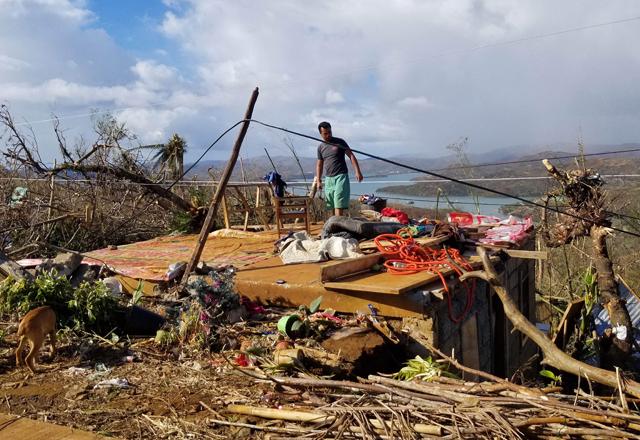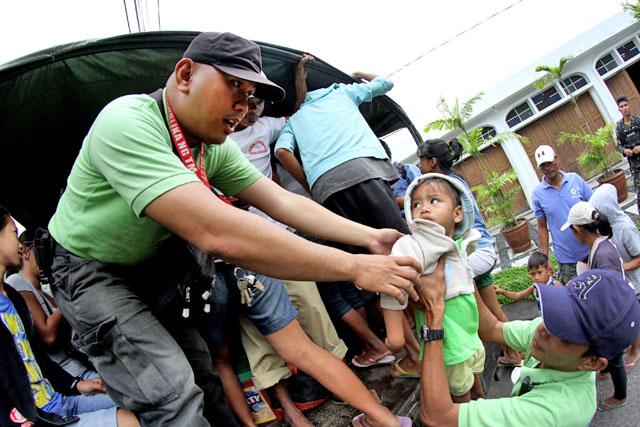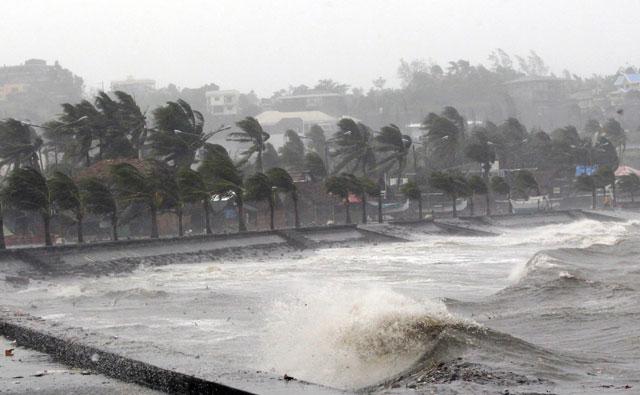You are here
Philippines typhoon death toll hits 375
By AFP - Dec 21,2021 - Last updated at Dec 21,2021

This handout photo taken on Sunday shows a resident standing on the ruins of his house caused by Super Typhoon Rai, in San Jose, Dinagat Island (AFP photo)
SURIGAO CITY, Philippines — The death toll from the strongest typhoon to hit the Philippines this year surged to 375 on Monday, as desperate survivors pleaded for urgent supplies of drinking water and food.
The Philippine Red Cross reported "complete carnage" in coastal areas after Super Typhoon Rai left homes, hospitals and schools "ripped to shreds".
The storm tore off roofs, uprooted trees, toppled concrete power poles, smashed wooden houses to pieces, wiped out crops and flooded villages — sparking comparisons to the damage caused by Super Typhoon Haiyan in 2013.
"Our situation is so desperate," said Ferry Asuncion, a street vendor in the hard-hit seaside city of Surigao, which was devastated by the storm.
Residents urgently needed "drinking water and food", he said.
At least 375 people were killed and 56 are missing in the latest disaster to hit the archipelago, with 500 more injured, the national police said.
More than 380,000 people fled their homes and beachfront resorts as Rai slammed into the country on Thursday.
One of the hardest-hit islands was Bohol — known for its beaches, "Chocolate Hills" and tiny tarsier primates — where at least 94 people have died, provincial Governor Arthur Yap said on Facebook.
Many wooden houses in Bohol's coastal town of Ubay were flattened and small fishing boats destroyed on the island, where a state of calamity has been declared.
A senior official at the national disaster agency said he had not expected as many deaths.
"I was proven wrong as it appears now coming from the reports," said Casiano Monilla, deputy administrator for operations.
Rai hit the Philippines late in the typhoon season: Most cyclones develop between July and October.
Scientists have long warned that typhoons are becoming more powerful and strengthening more rapidly as the world becomes warmer because of human-driven climate change.
The Philippines — ranked among the most vulnerable nations to the impacts of climate change — is hit by an average of 20 storms every year, which typically wipe out harvests, homes and infrastructure in already impoverished areas.
In 2013, Typhoon Haiyan was the strongest storm ever to have made landfall, leaving over 7,300 people dead or missing.
The death toll from Rai is not expected to get anywhere close to that number.
The Philippines has an established disaster management system that provides early warnings of approaching storms and moves vulnerable communities into evacuation centres.
But the storm has dealt a savage blow to the tourism sector, which was already struggling after COVID-19 restrictions decimated visitor numbers.
"SOS" has been painted on a road in the tourist town of General Luna on Siargao Island, where surfers and holidaymakers had flocked ahead of Christmas, as people struggled to find water and food.
"There's no water anymore, there's a water shortage, on day one there was already looting in our neighbourhood," Siargao resort owner Marja O'Donnell told CNN Philippines.
There has also been widespread destruction on Dinagat and Mindanao islands, which along with Siargao bore the brunt of the storm when it hit, packing wind speeds of 195 kilometres per hour.
Police reported 167 deaths in the Caraga region, which includes Dinagat, Siargao and the north-eastern part of Mindanao.
Related Articles
CALUMPUT, Philippines — The death toll from two storms which battered the Philippines rose to 45 Sunday as several towns remained under wate
A powerful typhoon roared into the eastern Philippines on Saturday, bringing lashing rain and strong winds that felled trees, ripped off tin roofs and toppled power lines in areas still bearing the scars of a super typhoon 13 months ago.
Typhoon Hagupit knocked out power, left at least three people dead and sent nearly 900,000 into shelters before it weakened Sunday, sparing the central Philippines the type of massive devastation that a monster storm brought to the region last year.



















